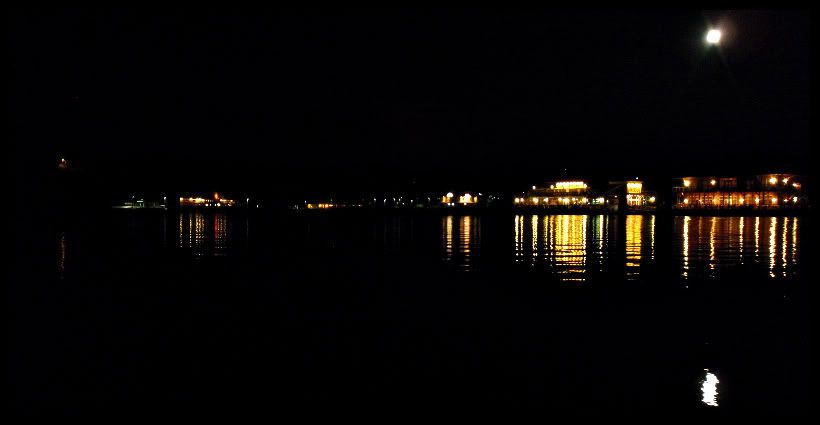After exploring the Muskoka Wharf (tourist) area yesterday, I decided to explore the town today. A wonderful mix of shops both eclectic and practical with community services, and just about everything is within walking distance. I stopped into the public library and found some great historical information on this fascinating community.
 I've lived in a number of different Ontario towns - some of them I liked and some I didn't, but a few of them call out to me as being home from the moment I step into them. First in Mattawa, then in Thunder Bay I settled into a community as well as a place, plus I found some really great living spaces (a geodesic dome, a cabin deep in the woods, a peaked attic apartment). Gravenhurst has that instant feeling of home to me. Bala is beautiful, but it has that seasonal cottage atmosphere; Huntsville and Port Carling just feel like the suburbs in a different setting; Haliburton is pristine but incredibly far away. Gravenhurst however has a storied history, an interesting town separate from their cottage country attractions, and a scenic/rugged/canadian shield feel that is only two hours from Toronto and accessible by train!
I've lived in a number of different Ontario towns - some of them I liked and some I didn't, but a few of them call out to me as being home from the moment I step into them. First in Mattawa, then in Thunder Bay I settled into a community as well as a place, plus I found some really great living spaces (a geodesic dome, a cabin deep in the woods, a peaked attic apartment). Gravenhurst has that instant feeling of home to me. Bala is beautiful, but it has that seasonal cottage atmosphere; Huntsville and Port Carling just feel like the suburbs in a different setting; Haliburton is pristine but incredibly far away. Gravenhurst however has a storied history, an interesting town separate from their cottage country attractions, and a scenic/rugged/canadian shield feel that is only two hours from Toronto and accessible by train! Named in 1862 and provided with a post office, Gravenhurst was the first official town in Muskoka. Previously it had been known as Sawdust City for the booming lumber industry it supported - at one time there were 28 operational mills. Before Gravenhurst was accessible by rail, 100+ teams of horses pulled stagecoaches along plank roads from Orillia and Barrie. When the railway finally reached the town in 1875 it opened up access to intrepid travellers followed by leisure tourists. In 1866 Wenonah, the first steamboat, was launched on the lake and 1887 the RMS Segwun was built right in Muskoka Bay where it still operates today as the oldest operational steamship in North America and the oldest registered vessel in Canada. The steamships met the trains in Gravenhurst completing the Muskoka Junction Railroad that brought visitors from Toronto, New York City and even as far as Pittsburgh and Philadelphia. Although they left the heat of the city for the cool lakes of Muskoka they brought with them an urban influence that is still felt today as they built and furnished cottages along the shore and sought entertainment in the few small towns.
One of Gravenhurst's most famous residents Dr. Norman Bethune - a distinguished and innovative surgeon and radical political Communist was born in 1890 in a Presbyterian Church Manse on John St. that is preserved today as a Parks Canada Memorial Site. Although Dr. Bethune would leave Gravenhurst with his family at the age of 3, he would return many years later as a tuberculosis patient at the Calydor Sanatorium.
Speaking of which, I should mention that there's a picturesque site just north of town, at the end the aptly named Sanatorium Rd. that's you probably should think twice about visiting. During WWII it was the site of a prisoner of war camp, that while apparently quite pleasant, was a detention centre nonetheless. After the war it became a sanatorium for tuberculosis patients, followed by an unsuccessful resort. Now it stands eerily empty and moderately guarded from urban explorers. I found an original of a book I still reference in horticulture class today: Sylvan Ontario, A Guide to Our Native Trees and Shrubs, first published in 1901 by one of the first local residents: Dr. William Hawthorne Muldrew (for whom Lake Muldrew is named). Final interesting fact: in 1930 a large fire threatened most of the town, in response to which the Ontario Fire College was established and still operates today.
Speaking of which, I should mention that there's a picturesque site just north of town, at the end the aptly named Sanatorium Rd. that's you probably should think twice about visiting. During WWII it was the site of a prisoner of war camp, that while apparently quite pleasant, was a detention centre nonetheless. After the war it became a sanatorium for tuberculosis patients, followed by an unsuccessful resort. Now it stands eerily empty and moderately guarded from urban explorers. I found an original of a book I still reference in horticulture class today: Sylvan Ontario, A Guide to Our Native Trees and Shrubs, first published in 1901 by one of the first local residents: Dr. William Hawthorne Muldrew (for whom Lake Muldrew is named). Final interesting fact: in 1930 a large fire threatened most of the town, in response to which the Ontario Fire College was established and still operates today.



Only moderately guarded eh? Interesting read Katie! Never been to Gravenhurst, or at least stopped there...sounds great though...family cottage there?
ReplyDeleteInstead of buying a cottage that we wouldn't be at for most of the summer (its my parents busy time at work) my parents rent a cottage for the last two weeks every summer.
ReplyDeletehttp://outlawathome.blogspot.com/2010/08/muskoka-soul.html